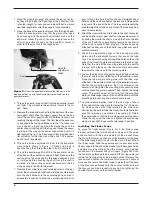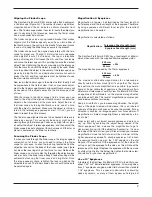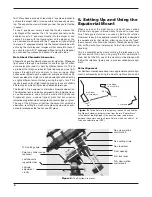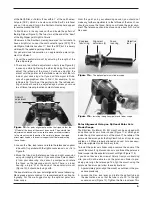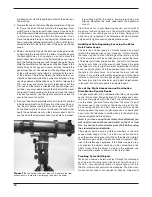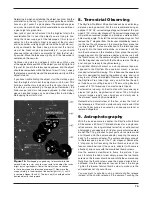
4
1. Stand the tripod legs upright and spread the legs out as far
as they will go. Keep the tripod legs at their shortest (fully
retracted) length, for now; you can extend them to a more
desirable length later, after the scope is fully assembled.
2. Place the base of the equatorial mount into the tripod head.
Orient the equatorial mount so that the post on the tripod
head lines up with the azimuth adjustment knobs on the
equatorial mount (Figure 2). You may need to loosen the
azimuth adjustment knobs on the equatorial mount in
order to fit the mount onto the tripod head.
3. Thread the central support shaft into the equatorial mount
until tight. This will secure the equatorial mount to the tri-
pod head.
4. Remove the knob and washer from the bottom of the cen-
ter support shaft. Slide the tripod support tray up the bot-
tom of the central support shaft until the three tray arms are
touching the legs of the tripod. The flat side of the accesso-
ry tray should be facing up. Make sure the “V” of each tray
arm is against a tripod leg. Place the washer back on the
center support shaft against the tray, and thread the secur-
ing knob all the way up the center support shaft until it is
tight against the tray. The tripod support tray provides addi-
tional stability for the tripod, and holds five 1.25" eyepiec-
es and two 2" eyepieces.
5. Thread the latitude adjustment L-bolts into the equatorial
mount where shown in Figure 1. Thread one L-bolt in
about halfway, then thread the other L-bolt in until tight.
6. Thread the counterweight shaft into the equatorial mount
at the base of the declination axis until tight. Make sure the
casting at the top of the shaft is threaded clockwise as far
as it will go before attaching the shaft. Once the shaft is
installed, turn the casting counter-clockwise until the top
of the casting is flush with the mount.
7. Remove the knurled “toe saver” retaining screw on the bot-
tom of the counterweight shaft and slide the counterweight
onto the shaft. Make sure the counterweight lock knob is
adequately loosened to allow the counterweight shaft to
pass through the hole. Position the counterweight about
halfway up the shaft and tighten the lock knob. Replace the
toe saver at the end of the bar. The toe saver prevents the
counterweight from falling on your foot if the lock knob hap-
pens to come loose.
8. Attach the slow-motion control knobs to the right ascension
and declination worm gear shafts of the equatorial mount
by sliding them onto the shafts. Line up the flat on the end
of the shaft with the corresponding feature on the interior
of the knob to connect them properly. The knobs can be
attached to either end of the shafts; use whichever end is
most convenient.
9. Attach the tube mounting rings to the tube ring mounting
plate using the attachment screws that are on the tube
rings. The screws should go through the holes on the outer
ends of the mounting plate and rethread into the tube rings.
Note that the side of the mounting plate with the central
“groove” will be facing up. Use the small crescent wrench
to secure the tube rings to the mounting plate.
10. Loosen the black mounting plate securing knob as well as
the metal safety screw on the top of the equatorial mount.
Place the tube ring mounting plate, with the tube rings
attached, in the dovetail slot on top of the equatorial mount.
Position the mounting plate so that it is centered on the
dovetail slot. Re-tighten the mounting plate securing knob
until the mounting plate is secure. Then, tighten the safety
screw. The safety screw will ensure that the mounting
plate (and telescope tube) will not fall off the EQ mount if the
mounting plate securing knob should come loose.
11. Lay the telescope optical tube in the tube rings at about
the midpoint of the tube’s length. Center the 1/4"-20 mount-
ing block on the optical tube relative to the tube rings.
Positioning the optical tube this way will automatically bal-
ance the telescope in declination (see section 4). Rotate
the optical tube so that the focus wheels are pointed down.
Close the rings over the tube and tighten the knurled ring
clamps finger-tight to secure the telescope in position.
installing the Finder scope
To place the finder scope (Figure 3a) in the finder scope
bracket, unthread the two black nylon screws until the screw
ends are flush with the inside diameter of the bracket. Place
the O-ring that comes on the base of the bracket over the body
of the finder scope until it seats into the slot on the middle of
the finder scope. Slide the eyepiece end (narrow end) of the
finder scope into the end of the bracket’s cylinder opposite the
adjustment screws while pulling the chrome, spring-loaded
tensioner on the bracket with your fingers (Figure 3b). Push
the finder scope through the bracket until the O-ring seats just
inside the front opening of the bracket cylinder. Release the
tensioner and tighten the two black nylon screws a couple of
turns each to secure the finder scope in place. Insert the base
of the finder scope bracket into the dovetail holder on top of
the focuser. Lock the bracket into position by tightening the
knurled thumb screw on the dovetail holder.
Figure 2.
Orient the equatorial mount so that the post on the
tripod head lines up with the azimuth adjustment knobs on the
equatorial mount.
Post
Azimuth
adjustment
knobs




